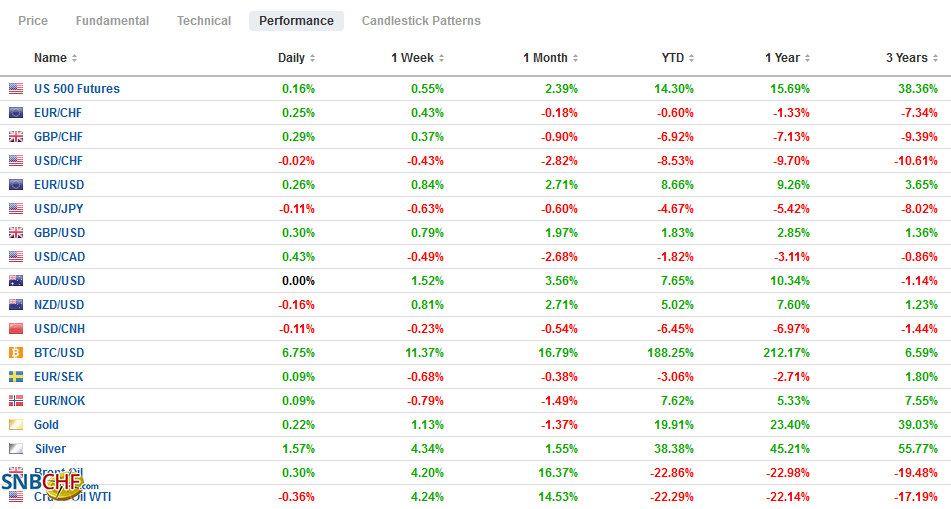Swiss Franc The Euro has risen by 0.26% to 1.0789 EUR/CHF and USD/CHF, December 16(see more posts on EUR/CHF, USD/CHF, ) Source: markets.ft.com - Click to enlarge FX Rates Overview: The S&P 500 snapped a four-day downdraft helped by optimism over the progress toward fiscal stimulus and some hope that a new trade deal can still be negotiated between the UK and EU. Europe reported better than expected PMIs. Equities are broadly higher, as are interest rates, while the dollar slumps. The MSCI Asia Pacific Index rose for the first time this week, while Europe’s Dow Jones Stoxx 600 is up for the third session and at a new 10-month high. US stocks are extending yesterday’s gains. Benchmark 10-year yields are edging 2-3 bp higher today in Europe. The 10-year
Topics:
Marc Chandler considers the following as important: 4) FX Trends, 4.) Marc to Market, Brexit, EU, Featured, Federal Reserve, newsletter, U.K., USD
This could be interesting, too:
Nachrichten Ticker - www.finanzen.ch writes Krypto-Ausblick 2025: Stehen Bitcoin, Ethereum & Co. vor einem Boom oder Einbruch?
Connor O'Keeffe writes The Establishment’s “Principles” Are Fake
Per Bylund writes Bitcoiners’ Guide to Austrian Economics
Ron Paul writes What Are We Doing in Syria?
Swiss FrancThe Euro has risen by 0.26% to 1.0789 |
EUR/CHF and USD/CHF, December 16(see more posts on EUR/CHF, USD/CHF, ) Source: markets.ft.com - Click to enlarge |
FX RatesOverview: The S&P 500 snapped a four-day downdraft helped by optimism over the progress toward fiscal stimulus and some hope that a new trade deal can still be negotiated between the UK and EU. Europe reported better than expected PMIs. Equities are broadly higher, as are interest rates, while the dollar slumps. The MSCI Asia Pacific Index rose for the first time this week, while Europe’s Dow Jones Stoxx 600 is up for the third session and at a new 10-month high. US stocks are extending yesterday’s gains. Benchmark 10-year yields are edging 2-3 bp higher today in Europe. The 10-year Treasury yield is firm around 0.92%. The greenback is trading lower against all the majors but the Canadian dollar. The euro has pushed above $1.22 and sterling above $1.35. Emerging market currencies are also mostly higher, and the JP Morgan Emerging Market Currency Index is at new 10-month highs. The Bannockburn World Currency Index (GDP-weighted) is at its best level since May 2018. Gold is extending yesterday’s strong gains and the next target is last week’s high near $1875. Recovery hopes lift crude prices. The January WTI contract is approaching $48, while Brent is testing $51. |
FX Performance, December 16 |
Asia Pacific
On a day of economic beats, Japan disappointed. First, the November trade surplus was less than expected at almost JPY367 bln. Exports were forecast to rise by 0.4% but instead fell by 4.2% year-over-year, and imports, which were to have fallen by 9.5%, dropped 11.1%. Of note, exports to the US were off 2.5%, to Europe, down 2.6%, while shipments to China rose 3.8%. Second, Japan’s preliminary PMI was mixed, but the manufacturing gain (49.7 vs. 49.0) was more than offset by the slippage in services (47.2 vs. 47.8). This saw the composite edge lower to 48.0 from 48.1. The yen’s strength today appears to be more a function of a weak dollar.
In contrast, despite the elevated tensions with its biggest trading partner, Australia’s PMI showed the recovery gaining momentum. The manufacturing PMI rose to 56.0 from 55.8. The services PMI rose to 57.4 from 55.1. That translates into the composite reading of 57.0 after 54.9 in November. Recall, last December, the composite was at 49.6, the second consecutive month below 50. Note that tomorrow Australia reports November employment data, which is the key to the central bank’s policy outlook.
The dollar is posting its first back-to-back decline against the Japanese yen this month. It is on its lows near JPY103.25 late in the European morning. The low since the spring chaos was set in early November, a little below JPY103.20. The JPY103 level offers psychological support reinforced by an option for roughly $350 mln that expires today. The low set in early March was closer to JPY101.20. The BOJ meets this week but is unlikely to say much about the yen’s exchange rate. The yen’s gains lag behind most others in Asia, including the Chinese yuan and the G10 over the past few months. The Australian dollar is firm near $0.7575. The next target is the $0.7600-$0.7625 area. Initial support is seen around $0.7550. The weak dollar keeps the Chinese yuan firm. The PBOC set the dollar’s reference rate at CNY6.5355, a little stronger than expected. The two days of yuan gains have offset the five-day downtrend that it snapped. Support is seen near CNY6.52 and then CNY6.50.
Europe
There are three developments to note in Europe today. First, constructive sounds from the UK-EU trade talks saw sterling rally about a cent in North America yesterday to about $1.3450. Reports suggested the UK has dropped its demand that fishing vessels that operate under the UK be majority British-owned. The Irish foreign minister Coveney was quoted in the press indicating some progress on the level-playing field issue. There is also an understanding that if an agreement is reached, the inability to ratify in time would not necessarily be a significant hurdle, as the EU has a “provisional application.” This would allow the agreement to be implemented on January 1, even if not formally approved by the European Parliament and the individual members.
| Second, the preliminary December PMIs surprised on the upside. The German manufacturing PMI rose to 58.6 from 57.8, while the services PMI increased to 47.7 from 46.0. The composite stands at 52.5 after 51.7. The French composite PMI rose to 49.6 from 40.6, after the manufacturing PMI rose back above 50 to 51.1 from 49.6, and its service PMI rose to 49.2 from 38.8. The pattern was repeated on the aggregate level, with the manufacturing growth accelerating (55.5 vs. 53.8) and slump in services moderating (47.3 vs. 41.7). The composite rose to 49.8 from 45.3. Of note, new orders rose for the first time since September, though unemployment slipped. |
Eurozone Trade Balance, October 2020(see more posts on Eurozone Trade Balance, ) Source: investing.com - Click to enlarge |
The UK reported better than expected PMI but softer than expected November inflation. The manufacturing PMI showed accelerated activity as it rose to 57.3 from 55.6. The service PMI did not rebound above 50 but did improve to 49.9 from 47.6. The composite did push back above 50 to 50.7 from 49.0. Fits the European pattern. Meanwhile, the preferred inflation measure, CPIH, which included owner-occupied housing cost fell to 0.6% (year-over-year) from 0.9% and was weaker than expected. Core CPI slowed to 1.1% from 1.1%. The Bank of England meets tomorrow. With no closure to the UK-EU negotiations, there is not much for it to do. The next meeting is not scheduled until February 4.
Third, Europe announced two initiatives. The ban on bank dividends was replaced by a conservative cap. Dividends and share buybacks will be capped at 15% of the 2019-2020 profits or 0.2% of the key capital ratio. In contrast, the UK lifted its ban last week and allows banks to payout 25% of the cumulative profits in 2019-20 or 0.2% of risk-weighted assets. The EC proposed legislation that is part of the new efforts to regulate the internet. It comes in the form of the Digital Markets Act and the Digital Services Act. The platform providers, or what the EU calls “gatekeepers,” won’t be permitted to rank their product or services above competitors or use competitor data to compete. Small acquisitions that ostensibly could change the playing field will also have to be reported. Also, the platforms have to remove terror propaganda and other illegal posts. This is beginning a long parliamentary process, but it will shape the debate going forward—clearer rules of engagement and penalties for violations, which could ultimately require divestment as well as fines. The UK, incidentally, announced similar rules.
The euro has traded above $1.22 for the first time since April 2018. The next important chart points are not seen until the $1.2300-$1.2350 band. Support is likely to be seen near previous resistance around $1.2175-$1.2180. Note that the upper Bollinger Band is near $1.2265 today. Sterling is extending yesterday’s recovery on Brexit hopes and on the back of the weak dollar. It traded around $1.3135 before the weekend and popped up to about $1.3520 in the European morning, where it stalled. Initial support now is seeing the $1.3460-$1.3480 area. The euro fell back to GBP0.9000 from above GBP0.9200 at the end of last week. The 200-day moving average for the cross is a little below $0.8990.
AmericaBefore the FOMC meeting concludes, the November retail sales report and the preliminary December PMI will be released. The economy cannot and is not sustained the 33.1% annualized pace of growth seen in Q2. Part of that slow down is a pullback in consumption. Retail sales account for a little more than 40% of US consumption (November report next week). We already know that auto sales slowed, which may be sufficient to drive headline retail sales below zero. The components used for GDP calculations, which exclude autos, gasoline, building materials, and food services, had already slowed sharply in October (to 0.1% from an average of 1.0% in Q3) and likely to be around that pace in November. The composite PMI is expected to slow from the 5 1/2-year high of 58.6 in October, but the US economy’s resilience so far is notable. |
U.S. Retail Sales YoY, November 2020(see more posts on U.S. Retail Sales, ) Source: investing.com - Click to enlarge |
We have suggested that the balance that the Fed is trying to strike is between the near-term downside risks and the virus remains out of control and the medium-term upside risks arising from the vaccine are soon likely to be two. On balance, this does not appear to warrant changing policy by boosting the amount of bonds it is buying ($80 bln of Treasuries and $40 bln of Agency MBS a month) or shifting its purchases toward the long-end. Given the lag time of monetary policy effects even under optimal conditions, it is not clear monetary policy can do much more to address this divergent risk profile. However, the Fed cannot let it go at that. It needs to say something about its bond purchases. As it did after the Great Financial Crisis, it will likely shift its forward guidance from time to conditions, from monthly to something like anticipating continuing at least at the present pace until the economic slack has been absorbed and the economy is on a clear path toward the objectives of full employment and price stability. One sign that the Fed’s effort to boost inflation expectations is working is that the yield curve steepens as the long-end backs up. Another sign is the breakevens (the difference between conventional and inflation-linked securities) widen. The Fed should be in no hurry to further weaken the signals the market is sending through seeking lean against the steepening and widening.
Canada reports November CPI today. As the median in the Bloomberg survey expects, a flat report would allow the year-over-year rate to creep up to 0.8% from 0.7%. However, the headline rate understates the price pressures, and officials put more weight on the underlying measures, core median, common, and trimmed. These measures are more stable and higher (1.6%-1.9%) and are expected to be little changed.
The US dollar fell to new 2.5-year lows yesterday, just below CAD1.2690. However, the greenback is bid in the European morning and is approaching resistance around CAD1.2760. A push above yesterday’s high (~CAD1.2770), and especially a close above it, would be a positive technical development for the US dollar. The move appears to be order-driven, and we suspect will provide an opportunity for North American participants to buy Canada. News that Mexico will postpone considering the controversial bill that would have the central bank buy dollars from local banks until February saw the peso rally yesterday to a three-day high, and follow-through buying today has pushed it to new highs for the week. The central bank meets tomorrow, and it is expected to stand pat with a 4.25% target rate. The greenback traded on both sides of Monday’s range yesterday and settled below the low. The price action reinforces the importance of resistance around MXN20.25. Initial support is near MXN19.80, but the risk is a re-test of last week’s lows closer to MXN19.70.
Graphs and additional information on Swiss Franc by the snbchf team.
Tags: #USD,Brexit,EU,Featured,federal-reserve,newsletter,U.K.









